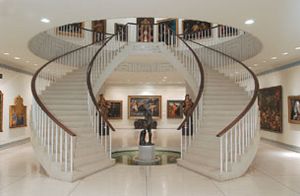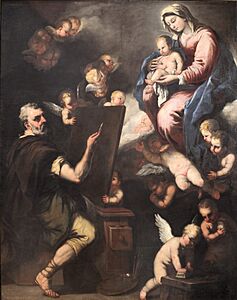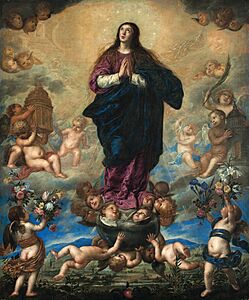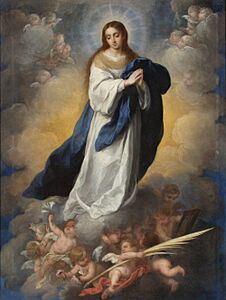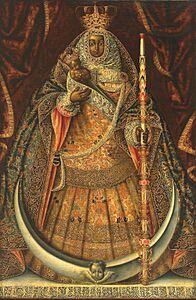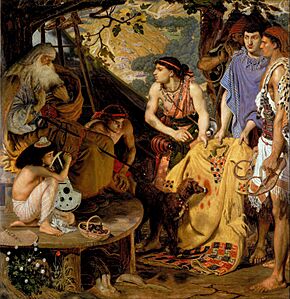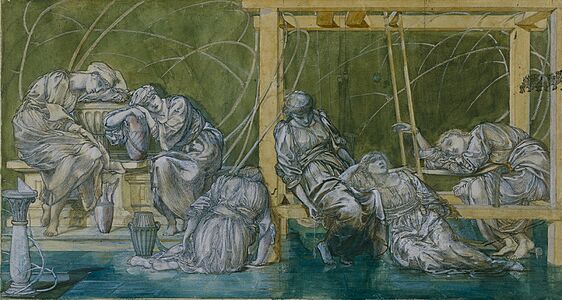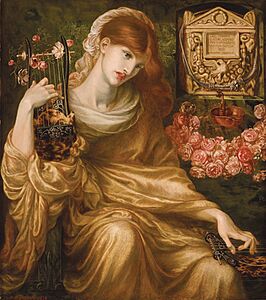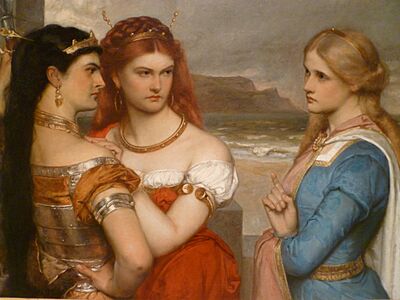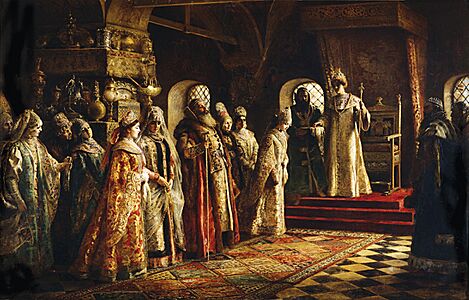Museo de Arte de Ponce facts for kids
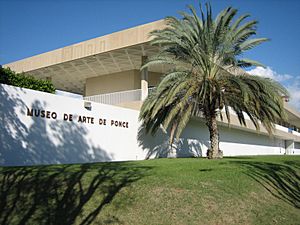
Exterior view of the museum
|
|
| Established | 1959 |
|---|---|
| Location | 2325 Avenida Las Américas, Ponce, Puerto Rico |
| Type | Art museum |
| Accreditation | American Alliance of Museums |
| Key holdings | -Flaming June -The Last Sleep of Arthur in Avalon |
| Collections | Baroque Pre-Raphaelite Golden Age Latin American art Puerto Rican art |
| Collection size | 4,500 pieces (2010) |
| Visitors | 90,000 (2010) |
| Architect | Edward Durell Stone |
| Owner | Private: Fundación Luis A. Ferré, Inc. |
| Public transit access | SITRAS, "Linea Anaranjada" (Orange Line): Buses E, F, G (Museo stop) |
The Museo de Arte de Ponce (MAP) is a famous art museum located in Ponce, Puerto Rico. It has a large collection of European art and pieces by Puerto Rican artists. The museum is known for having one of the most important collections of Pre-Raphaelite art in the Western Hemisphere. It displays about 4,500 artworks in its fourteen galleries.
Many people consider the Museo de Arte de Ponce to be the best art museum in Puerto Rico. It is also the largest art museum in the Caribbean. Some even say it is one of the best in the Americas. It was the first museum in Puerto Rico to be approved by the American Alliance of Museums.
The museum was started in 1959 by Luis A. Ferré, a successful businessman and philanthropist. It first opened in a different location in Ponce Historic Zone. In 1965, the museum moved to its current building on Avenida Las Américas. In 2010, the museum became much bigger after a major expansion project.
Contents
History of the Museum
How the Museum Started
The idea for the museum began in 1956. Luis A. Ferré traveled to Europe and bought many European art pieces. These included several Pre-Raphaelite artworks. This inspired him to create a museum in his hometown of Ponce.
Ferré got advice from two art experts. They helped him choose artworks based on their value, not just their popularity. Ferré once said that many experts thought his choices were "crazy."
Opening and Growth
On January 3, 1959, Ferré opened the museum. It was in a house on Cristina Street in Ponce. This building is now the Centro Cultural de Ponce. The first exhibit showed 72 artworks. Some of these original paintings are still on display today. As the museum became more popular, more artworks were added. In 1962, the Samuel H. Kress Foundation gave 15 paintings to the museum.
Moving to a New Building
Ferré was worried that a fire might destroy the art collection. So, he bought land on Las Americas Avenue in Ponce. He hired architect Edward Durell Stone to design a new museum building. Construction began on April 23, 1964. The new building was finished in 1965 and opened on December 28, 1965.
One special part of the museum's design is its hexagonal (six-sided) galleries. These allow natural light to enter, making the art look amazing. The museum had 14 galleries, two gardens, and an amphitheater. Its main entrance has unique split staircases.
Art and Expansion
In 1984, a large aluminum sculpture called Pinceladas en Vuelo ("Brushstrokes in Flight") was placed in front of the museum. It was created by New York artist Roy Lichtenstein. This 28-foot-high sculpture was considered the largest public art piece in Latin America and the Caribbean at the time. By 1989, the museum's collection had grown to 500 pieces.
From 2008 to 2010, the museum was closed for big renovations. It reopened for its 50th anniversary on November 13, 2010. The improvements cost about $30 million. During the closure, the museum held exhibits in San Juan. It also loaned some of its best artworks to other museums around the world.
The construction work made the museum much larger, increasing its size by over 40%. The renovations added a new building for a historic archive and a library. This new part of the museum is about 37,745 square feet. It includes educational spaces, an art history library, and a lab for art conservation. There is also an art storage area, a museum shop, a restaurant, and offices. After the expansion, the museum's total size became 77,745 square feet.
The main road where the museum is located was renamed "Luis A. Ferré Boulevard." This was done to honor the museum's founder. In 2021, the museum received the National Medal for Museum and Library Service. This is a very important award.
Amazing Artworks at the Museum
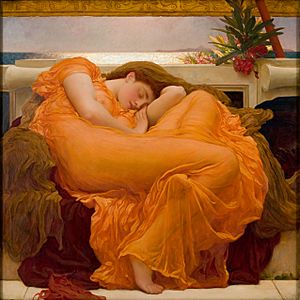
European and Latin American Art
The Museo de Arte de Ponce has one of the most important collections of European art in Latin America. The Financial Times newspaper called it "one of the most distinguished private collections" outside the United States. The museum has nearly 4,000 artworks. These pieces range from the 14th to the 20th century. You can see Italian Baroque art, British Pre-Raphaelite art, Spanish Golden Age art, and modern Latin-American art.
Some famous artists whose works are shown here include Peter Paul Rubens, Lucas Cranach, Bartolomé Esteban Murillo, Eugène Delacroix, and Sir Edward Burne-Jones.
Famous Masterpieces
The most famous painting at the museum is Flaming June. It was painted by Frederic Leighton. Luis A. Ferré bought this painting for less than $1,000 in Amsterdam in 1960. It was his favorite artwork.
Another very important painting is The Last Sleep of Arthur in Avalon. This was the final and greatest work by Sir Edward Burne-Jones. Ferré bought this huge painting in 1963. It was started in 1881 and was not finished when the artist died in 1898. In 2009, both Flaming June and The Last Sleep of Arthur in Avalon were loaned to Tate Britain in London. Other paintings were loaned to the Museo del Prado in Madrid.
Puerto Rican Art
The museum also has a very important collection of Puerto Rican art. This collection covers art from the 18th century to today. It includes works by great masters like José Campeche, Francisco Oller, and Miguel Pou. You can also see art by talented modern artists such as Myrna Báez, Francisco Rodón, Antonio Martorell, and Arnaldo Roche Rabell.
The museum also shows works by artists from other countries. For example, in March 2006, the museum displayed art by Mexican artist Frida Kahlo.
Supporting the Museum
The museum charges a small fee to enter. However, most of its money comes from generous donations. These donations are made by people and businesses in Puerto Rico. Some people donate money specifically to buy new art for the museum. Others donate to help with the museum's daily costs and upkeep. A special bronze plaque at the entrance thanks these important donors.
Selected collection highlights
-
Saint Rosalia Interceding for the City of Palermo (c. 1624-1629) by Anthony van Dyck
-
The Immaculate Conception (1657) by Antonio de Pereda
-
The Immaculate Conception of the Blessed Virgin Mary (1678) by Bartolomé Esteban Murillo
-
The Flight into Egypt (between 1660 and 1700) by Matías de Arteaga y Alfaro
-
Virgin of Candelaria (c. 1700-1725) by Cristóbal Hernández de Quintana
-
Brown's Jacob and Joseph's Coat (1864) by Ford Madox Brown
-
The Garden Court (1870) by Edward Burne-Jones
-
Roman Widow (1874) by Dante Gabriel Rossetti
See also
 In Spanish: Museo de Arte de Ponce para niños
In Spanish: Museo de Arte de Ponce para niños


